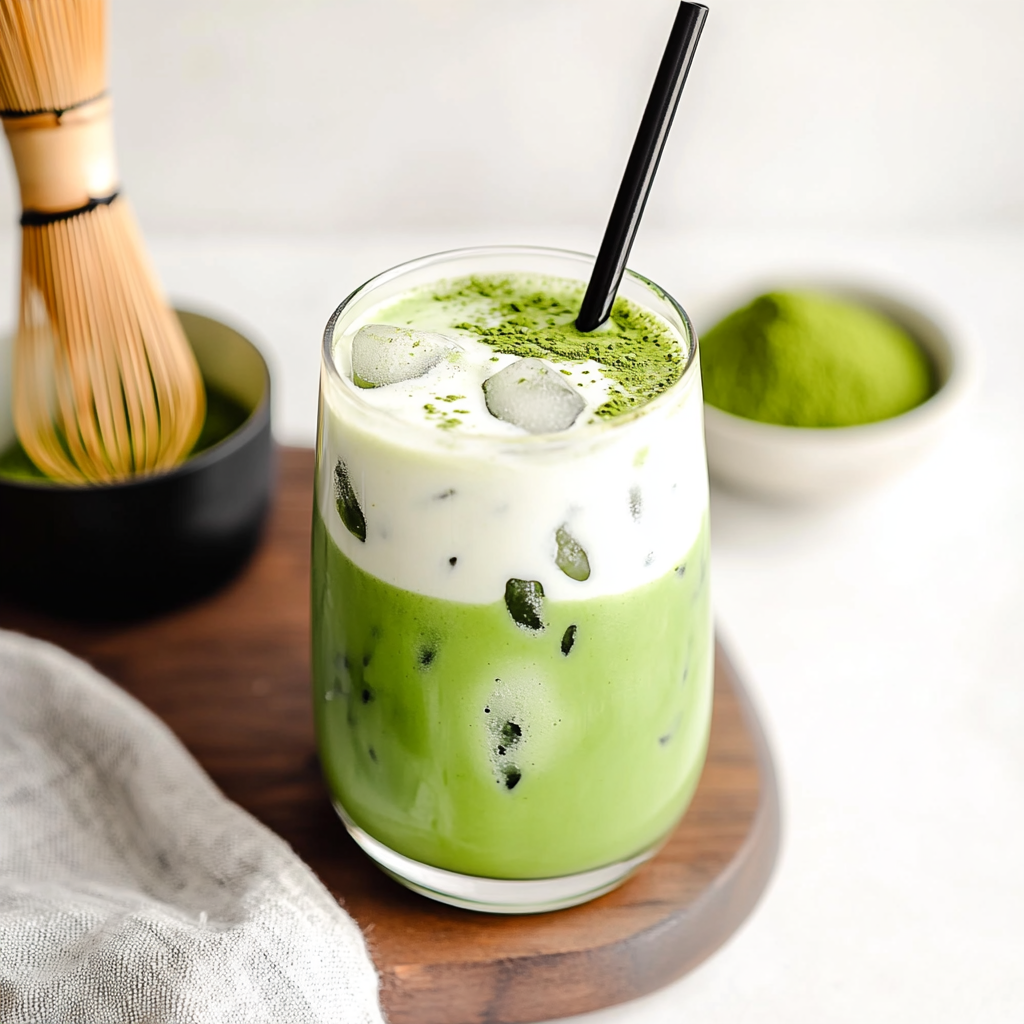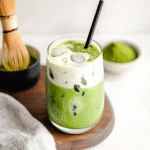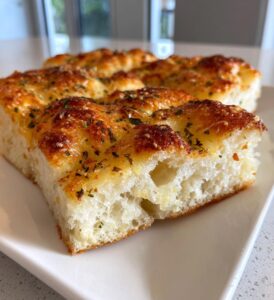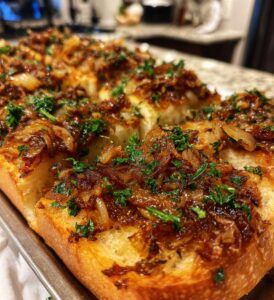A tall glass of iced matcha latte is more than just a refreshing drink — it’s a blend of tradition, wellness, and modern café culture. Made with finely ground green tea leaves, creamy milk, and a touch of sweetness, this chilled beverage offers a balanced mix of earthy flavors and vibrant energy. Whether you’re a matcha beginner or a seasoned tea lover, learning how to make it at home means you can control the flavor, sweetness, and health benefits. This guide covers everything from its origins and nutritional perks to step-by-step recipes and creative variations. Looking for inspiration? Try our Matcha Bubble Tea – The Complete Guide to Flavor, Health Benefits, and Recipes for another twist on matcha drinks.

Introduction to Iced Matcha Latte
What Is an Iced Matcha Latte?
An iced matcha latte is a cold beverage made by mixing matcha powder — a finely milled green tea — with water, milk, and ice. Unlike regular green tea, matcha is consumed in its powdered form, so you’re drinking the entire tea leaf. This means you get a stronger flavor, a richer texture, and a bigger boost of antioxidants. It’s often enjoyed sweetened, though the level of sweetness can be adjusted to taste.
Why It’s Becoming a Popular Summer Drink
There’s a reason coffee shops from Tokyo to New York are adding iced matcha latte to their summer menus. Not only is it visually striking with its green-and-white layers, but it’s also a healthier alternative to sugary sodas and energy drinks. Thanks to its moderate caffeine content, it provides a gentle energy boost without the jitters coffee sometimes causes. Plus, it’s incredibly versatile — you can make it dairy-free, sugar-free, or even add flavors like vanilla or coconut to suit your mood.
The Origins and Benefits of Matcha
A Brief History of Matcha in Japan and Beyond
Matcha’s story begins in China during the Tang Dynasty, where tea leaves were steamed and pressed into bricks for easy transport. The powdered tea-making method traveled to Japan in the late 12th century with Zen Buddhist monks, who valued it for meditation focus and sustained energy. Over time, Japan refined matcha into a ceremonial drink, particularly through the Japanese tea ceremony — a practice blending mindfulness, hospitality, and aesthetics. In the past decade, matcha has surged in popularity worldwide, thanks to both its health appeal and the Instagram-worthy drinks it creates.
Nutritional Benefits and Antioxidants in Matcha
Matcha stands out because you’re consuming the whole leaf, not just steeping it. This means a higher concentration of catechins — powerful antioxidants known to fight free radicals and support cell health. One of these catechins, EGCG (epigallocatechin gallate), has been studied for potential benefits like improved metabolism, heart health, and even skin health. Matcha also contains L-theanine, an amino acid that promotes calm focus, balancing the stimulating effect of its caffeine. This combination makes iced matcha latte a smart choice for a steady energy lift without a crash. Discover great ideas like our Garden Vegetable Pie – The Ultimate Guide to a Flavorful Homemade Dish if you’re looking for other healthy recipes.
Ingredients Needed for an Authentic Iced Matcha Latte
Choosing the Best Matcha Powder for Cold Drinks
Not all matcha powders are created equal. For an iced matcha latte, you’ll want ceremonial grade matcha — the highest quality, with a vibrant green color, fine texture, and smooth, slightly sweet flavor. Culinary grade matcha is more affordable but often more bitter, making it better for baking rather than lattes. When buying, look for:
- Origin (Japan’s Uji and Nishio regions are renowned for matcha)
- Bright, grassy green color (not dull or brownish)
- Fine, lump-free texture
- Airtight, light-proof packaging to protect freshness
Cold drinks highlight matcha’s delicate flavors, so quality really matters here.
Milk Options: Dairy, Almond, Oat, and Coconut
The choice of milk can completely change the flavor and creaminess of your iced matcha latte.
- Dairy milk (whole or 2%) creates a rich, café-style texture.
- Almond milk offers a nutty undertone with fewer calories.
- Oat milk is naturally sweet, thick, and foams beautifully — a favorite for barista drinks.
- Coconut milk gives a tropical twist and extra creaminess.
For best results, choose unsweetened versions so you can control the sweetness level yourself. Check out our Elvis Presley Cake – The Sweet Southern Dessert with a Rock ’n’ Roll Twist if you want a unique dessert pairing with your iced matcha latte.
Step-by-Step Recipe for Iced Matcha Latte
Traditional Preparation Method with a Bamboo Whisk (Chasen)
The classic Japanese method for making an iced matcha latte delivers a smooth, frothy texture and balanced flavor. Here’s how to do it:
- Sift the matcha powder – Place 1 to 2 teaspoons of ceremonial grade matcha into a fine-mesh sifter over a bowl. Sifting removes clumps, ensuring a silky drink.
- Add water – Pour 2 ounces of cold filtered water over the matcha.
- Whisk until frothy – Using a bamboo whisk (chasen), whisk in a zigzag motion until a fine layer of foam forms.
- Add milk and ice – Fill a tall glass with ice cubes, pour in 6–8 ounces of cold milk of choice, then top with the whisked matcha.
- Sweeten to taste – Stir in honey, maple syrup, or agave if desired.
Pro Tip: Whisking in cold water first prevents clumping and preserves the matcha’s vibrant color.
Quick Blender Method for Busy Mornings
If you’re short on time, a blender makes the process even easier:
- Add 1 to 2 teaspoons of matcha powder, 2 ounces of water, 6–8 ounces of milk, sweetener, and a handful of ice to the blender.
- Blend for 20–30 seconds until smooth and frothy.
- Pour into a tall glass and enjoy immediately.
This method is perfect for those who want café-quality results without special tools. Don’t miss our Matcha Bubble Tea – The Complete Guide to Flavor, Health Benefits, and Recipes for another creative matcha drink you can make at home.
Print
Iced Matcha Latte – The Ultimate Guide to Making the Perfect Chilled Green Tea Drink
- Total Time: 5 minutes
- Yield: 1 serving 1x
- Diet: Vegetarian
Description
A refreshing blend of ceremonial grade matcha, milk, and ice, offering earthy flavor, vibrant color, and a gentle energy boost — perfect for summer.
Ingredients
- 1–2 teaspoons ceremonial grade matcha powder
- 2 ounces cold filtered water
- 6–8 ounces milk of choice (dairy, almond, oat, or coconut)
- Ice cubes
- Sweetener to taste (honey, maple syrup, agave, or sugar-free alternative)
Instructions
- Sift the matcha powder into a bowl to remove clumps.
- Pour in the cold filtered water.
- Whisk in a zigzag motion with a bamboo whisk until smooth and frothy.
- Fill a tall glass with ice cubes.
- Pour in the milk of your choice.
- Slowly pour the whisked matcha over the milk to create layers.
- Sweeten to taste and stir if desired.
Notes
For best flavor, use high-quality ceremonial grade matcha. Whisking in cold water first prevents clumps and preserves the vibrant green color.
- Prep Time: 5 minutes
- Cook Time: 0 minutes
- Category: Beverage
- Method: No Cook
- Cuisine: Japanese
Nutrition
- Serving Size: 1 glass
- Calories: 80
- Sugar: 6g
- Sodium: 50mg
- Fat: 2g
- Saturated Fat: 1g
- Unsaturated Fat: 1g
- Trans Fat: 0g
- Carbohydrates: 12g
- Fiber: 1g
- Protein: 3g
- Cholesterol: 5mg
Keywords: matcha, iced latte, green tea, summer drink, Japanese beverage
Flavor Variations and Add-Ins
Sweeteners: Honey, Maple Syrup, and Agave
The beauty of an iced matcha latte is its adaptability. Sweetness is a personal preference, and you can fine-tune it to match your taste or dietary needs:
- Honey – Adds floral depth and pairs beautifully with the earthy notes of matcha.
- Maple syrup – Brings a rich, caramel-like sweetness perfect for cozy autumn vibes.
- Agave nectar – A light, neutral sweetness that dissolves quickly in cold drinks.
If you prefer a sugar-free option, stevia or monk fruit sweeteners work well without overpowering the flavor.
Creative Twists: Vanilla, Mint, and Fruit Infusions
Once you’ve mastered the classic iced matcha latte, you can explore endless variations:
- Vanilla matcha latte – Add a splash of vanilla extract for a soft, dessert-like note.
- Mint matcha latte – Muddle fresh mint leaves in the glass before adding ice for a refreshing summer twist.
- Fruit-infused matcha – Blend in mango, pineapple, or strawberry for a tropical burst of flavor and extra nutrients.
You can also sprinkle cinnamon, cardamom, or nutmeg for a warm spice kick that pairs beautifully with the creaminess of the latte.
Common Mistakes to Avoid
Why Matcha Clumps and How to Fix It
One of the most common complaints when making iced matcha latte at home is those stubborn green clumps floating in the glass. This happens because matcha powder is extremely fine and tends to stick together. To fix it:
- Always sift your matcha powder before mixing.
- Use a small amount of cold water first to create a smooth paste before adding milk or ice.
- Whisk in a zigzag motion instead of stirring in circles — this helps break up particles evenly.
Skipping these steps will leave your drink gritty, which can ruin the smooth, creamy experience you’re aiming for.
Over- or Under-sweetening Your Drink
Matcha has a naturally earthy, slightly bitter taste, so sweetening is often necessary for balance. However, overdoing it can mask its unique flavor, while under-sweetening can make it taste too grassy.
- Start with ½ to 1 teaspoon of sweetener, taste, then adjust.
- Remember that some milk alternatives like oat milk already add natural sweetness.
- If you’re making a fruit-infused matcha latte, factor in the fruit’s sugar content.
By avoiding these pitfalls, you’ll keep your iced matcha latte vibrant, balanced, and refreshing every time.
Health Considerations and Caffeine Content
Is Iced Matcha Latte Healthy? The Pros and Cons
An iced matcha latte can be a very healthy drink — but it depends on how you make it. On the plus side, matcha is packed with antioxidants, particularly catechins, which may help protect cells from oxidative damage. It also contains L-theanine, an amino acid that promotes calm focus, making it a smart alternative to coffee. However, watch out for added sugars and flavored syrups, which can quickly turn it into a calorie-heavy beverage. Choosing unsweetened milk alternatives and natural sweeteners can help you enjoy its benefits without the sugar overload.
Caffeine in Matcha vs Coffee
Matcha contains about 60–70 mg of caffeine per teaspoon, while an average cup of coffee has about 95 mg. While matcha has less caffeine overall, it delivers a longer-lasting energy boost because L-theanine slows the absorption. This means no sudden spikes or crashes — perfect for those sensitive to coffee jitters. For an iced matcha latte, using one to two teaspoons of matcha powder will give you enough caffeine to stay alert without feeling overstimulated.
Serving and Presentation Tips
Best Glassware for Aesthetic Presentation
An iced matcha latte isn’t just about flavor — presentation matters too, especially if you want that café vibe at home. Tall, clear glasses are the best choice, as they show off the drink’s signature green-and-white layers. Mason jars are another popular option, adding a rustic charm that’s perfect for social media shots. If you’re serving guests, try stemless wine glasses or highball glasses for a more refined look.
Layering Techniques for a Café-Style Look
The hallmark of a stunning iced matcha latte is the striking separation of milk and matcha before you stir it together. Here’s how to achieve it:
- Fill your glass with ice cubes.
- Pour cold milk into the glass until it’s about three-quarters full.
- Prepare your matcha separately with water (whisk or blend until smooth).
- Slowly pour the matcha over the milk, letting it float on top before naturally blending.
Pro Tip: Use larger ice cubes to slow mixing and preserve the layered effect longer. If you plan to photograph your drink, garnish with a mint sprig or a sprinkle of matcha powder on top for extra visual appeal.
FAQs About Iced Matcha Latte
How do you make an iced matcha latte?
Sift 1–2 teaspoons of matcha powder into a bowl, add a small amount of cold water, and whisk until smooth. Fill a glass with ice, pour in cold milk, and top with the whisked matcha. Sweeten to taste and enjoy immediately.
Is matcha latte good for your health?
Yes — especially if you use high-quality matcha and limit added sugars. It’s rich in antioxidants, contains L-theanine for calm focus, and has less caffeine than coffee.
Can you drink matcha tea cold?
Absolutely. Matcha can be enjoyed both hot and cold. In its iced form, it’s refreshing and still retains its full nutritional benefits.
What is a matcha latte?
It’s a drink made with matcha powder, water, and milk — served hot or cold — combining the earthy flavor of green tea with the creamy smoothness of milk.
Conclusion
An iced matcha latte is more than just a drink — it’s a refreshing blend of Japanese tradition, modern café culture, and personal creativity. From selecting the best ceremonial grade matcha to experimenting with flavors like mint or vanilla, every detail makes a difference. By avoiding common mistakes and paying attention to presentation, you can craft a drink that’s as beautiful as it is delicious. Whether you’re after a midday pick-me-up or a healthier coffee alternative, this chilled green tea latte offers both taste and wellness benefits.
Looking for inspiration? Try our Matcha Bubble Tea – The Complete Guide to Flavor, Health Benefits, and Recipes next for another fun way to enjoy matcha.
For daily recipes you can follow me on Facebook and Pinterest.


